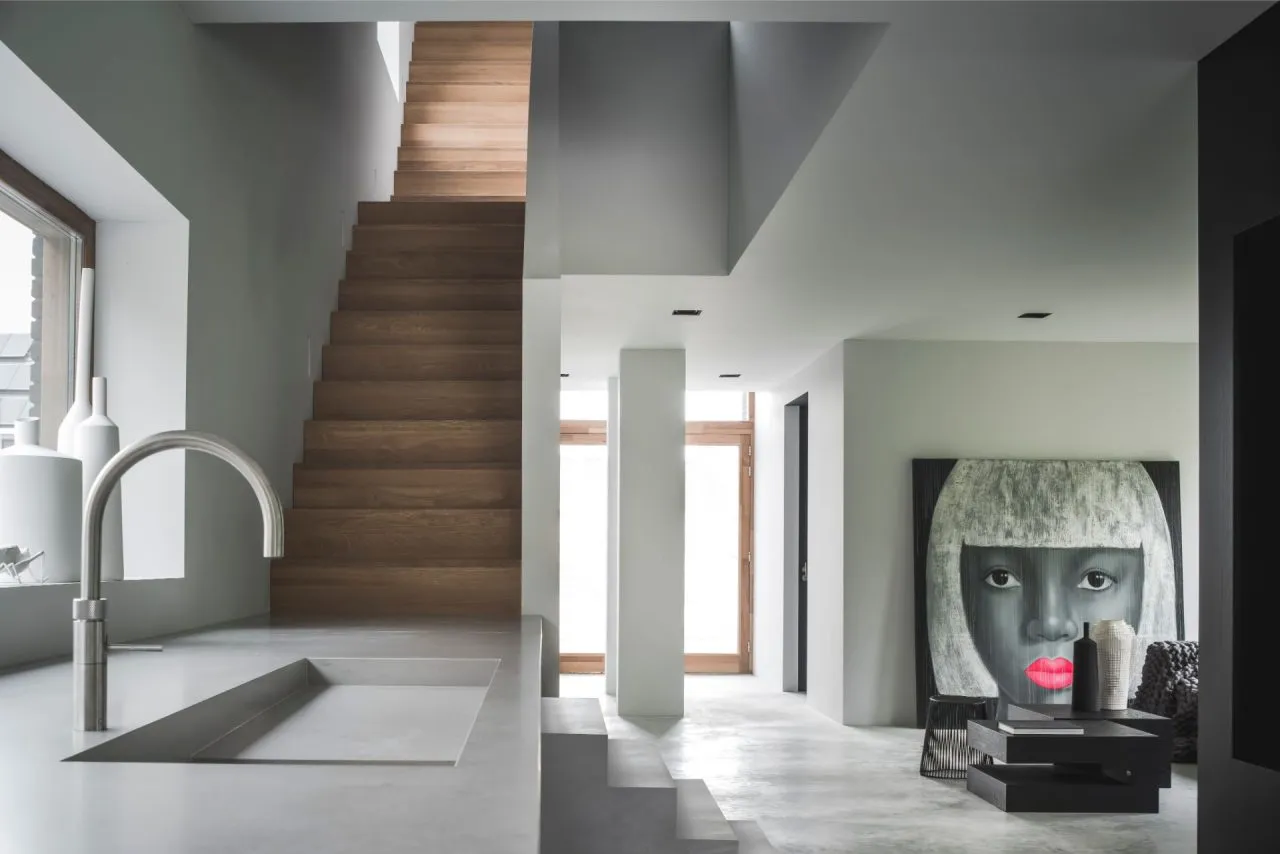Get ready to be amazed by Dutch interior design! It’s like a perfect balance of style and comfort, with a touch of history and modern flair. From the way they use natural light to the way they mix old and new pieces, Dutch design is all about creating a home that feels both sophisticated and inviting. So, let’s dive into the secrets of this incredible design style and see how we can make our own homes more beautiful and cozy.
Dutch Interior Design
Ever walked into a room and felt instantly calm and collected? That’s the magic of Dutch interior design! This unique design philosophy centers on simple elegance and effortless functionality, drawing inspiration from the natural world.
At its core, Dutch interior design is about keeping things simple and functional. It’s about creating a home that’s both beautiful and livable, where every piece has a purpose and there’s no room for clutter. Think clean lines, unfussy furniture, and a sense of spaciousness that instantly puts you at ease. Imagine a classic, sturdy Dutch house, built to last through the ages, filled with natural light, airy spaces, and a sense of calm that invites you to relax and unwind.
But it’s not just about minimalism. The Dutch have a deep appreciation for nature, and this is reflected in their design choices. They love bringing the outdoors in, using natural materials like warm wood, sturdy stone, and rich leather to add warmth and texture. Earthy tones like warm browns, soothing greens, and pops of burnt orange further enhance this connection to nature, instantly making you feel grounded and relaxed. Large windows bathe your home in natural light, connecting you to the world outside, further emphasizing this harmonious balance.
Here’s the fun part: Dutch design isn’t afraid to play with shapes and arrangements. Think geometric patterns on cushions and rugs, or an unexpected mix of furniture styles that somehow just works. It’s about creating a space that’s visually interesting without feeling overwhelming.
Key Elements of Dutch Interior Design:
- Simplicity: Clean lines, uncluttered spaces, purposeful furniture
- Nature Connection: Abundant natural light, earthy tones, natural materials (wood, stone, leather)
- Neutral Palette: Base colors of white, gray, beige, with accents of color and texture from natural elements
- Geometric Shapes: Geometric patterns on textiles and asymmetrical furniture arrangements
- Sustainability: Eco-friendly materials and energy-efficient solutions
Ready to bring a touch of Dutch design into your own home? Here’s how:
- Start with a Neutral Base: Think of your walls and large furniture pieces as a blank canvas. Opt for calming neutrals like white, gray, or beige.
- Invite Nature In: Incorporate natural materials whenever possible. Wood floors, a stone countertop, or a leather armchair can make a big difference. Don’t forget the plants!
- Embrace Geometric Fun: Add visual interest with geometric patterns on rugs, throws, or artwork. Try an asymmetrical furniture arrangement for a modern touch.
- Maximize Natural Light: Open those curtains and let the sunshine in! If possible, consider larger windows or skylights.
- Think Sustainable: Choose eco-friendly paint, recycled materials, and energy-efficient appliances. It’s about creating a beautiful home while being mindful of the planet.
Dutch interior design is more than just a style – it’s a lifestyle choice. It’s about creating a space that’s a true reflection of you: calm, collected, and connected to the beauty of the natural world.
What Defines Dutch Interior Design?
The Dutch style isn’t just about looks; it’s about a feeling. Imagine stepping into a space that feels both grand and welcoming, where history whispers through the clean lines and simple elegance. That’s the magic of Dutch design – a perfect blend of old-world charm and modern practicality, where beauty and functionality exist in perfect harmony.
Think of it like this: picture a classic, sturdy Dutch house, built to last through the ages. Now imagine that house filled with natural light, airy spaces, and a sense of calm that invites you to relax and unwind. You’re getting close to the essence of Dutch interior design.
Let’s break down some of the key elements that make this style so unique:
1. Keeping it Clean and Natural
- Less is More: Dutch interiors aren’t about clutter or flashy decorations. Think clean lines, simple furniture, and a focus on open space. It’s all about creating a sense of tranquility and balance.
- Nature’s Touch: Wood, stone, linen – Dutch design loves bringing the outdoors in. These natural materials add warmth and texture, creating a space that feels connected to the earth.
- Neutral Territory: Imagine a palette of soft grays, warm whites, and earthy tones. These serene hues form the backdrop of a Dutch interior, allowing the beauty of natural light and textures to shine.
2. Where Beauty Meets Brains
- Every Inch Counts: In Dutch design, form follows function. Spaces are designed to be both beautiful and practical, where every piece of furniture has a purpose and every corner is maximized.
- Storage Solutions: Built-in cabinets, clever shelving, hidden compartments – these are the hallmarks of Dutch ingenuity. They love finding creative ways to keep things organized without sacrificing style.
3. Creating a Cozy Haven
- Texture is Key: Think plush rugs, chunky knit blankets, and soft linen curtains. These tactile elements add layers of comfort and visual interest to a space.
- Light Up the Mood: Soft, warm lighting is essential in Dutch design. Candles, lamps, and strategically placed lighting fixtures create a cozy and inviting ambiance.
- Personal Touches: While simplicity is key, Dutch interiors aren’t afraid to show personality. Family heirlooms, vintage finds, and artwork add character and tell a story.
Bringing Dutch Design Home
You don’t have to live in the Netherlands to enjoy the beauty of Dutch design. Here are a few simple ways to incorporate this timeless style into your own home:
- Declutter and simplify: Start by clearing out unnecessary items and creating a sense of openness.
- Embrace natural elements: Incorporate wood furniture, stone accents, and natural textiles like linen and wool.
- Choose a neutral color palette: Opt for calming hues like whites, grays, and earthy tones.
- Add warmth with lighting: Use soft, warm lighting to create a cozy and inviting atmosphere.
- Incorporate personal touches: Don’t be afraid to add your own unique style with artwork, family photos, or travel souvenirs.
Dutch interior design is more than just a trend; it’s a philosophy of living. It’s about creating spaces that are both aesthetically pleasing and deeply livable, where beauty and functionality exist in perfect harmony.
Exploring the History and Evolution of Dutch Interior Design
Dutch design didn’t just pop out of nowhere – it has a story to tell, a story that’s all about blending beauty and practicality. Picture the Netherlands back in the 17th century, a time known as the Dutch Golden Age. This was a period of booming trade and cultural exchange, where the Netherlands rubbed shoulders with the world. This vibrant atmosphere heavily influenced Dutch interior design, which took cues from the fancy details of Early Flemish Baroque but kept things grounded in local traditions. The result? A style all its own, one that valued simplicity, functionality, and a deep respect for nature.
Over the years, Dutch design has evolved, embracing new ideas and technologies while staying true to its roots. Contemporary Dutch designers constantly push the boundaries, experimenting with new materials and technologies to create spaces that are both innovative and welcoming, always keeping the human experience at the forefront.
A Closer Look at What Makes Dutch Design Tick
Imagine walking into a room where everything has its place, where there’s a sense of calm and orderliness – that’s the essence of Dutch design. Clean lines and uncluttered spaces are like its building blocks, and furniture isn’t just there to look pretty, it has a purpose. But don’t think for a second that this means cold and sterile. Dutch design embraces natural materials like warm wood, sturdy stone, and rich leather, bringing a sense of coziness and texture to the scene. And when it comes to color, think serene and neutral – a backdrop that whispers rather than shouts. To keep things interesting, geometric shapes and unexpected arrangements add a touch of visual spice.
More Than Just Looks: Sustainability at Its Core
Dutch design isn’t just about creating spaces that look good; it’s about creating spaces that are good for the planet too. Sustainability is practically woven into its DNA. Think eco-friendly materials and clever energy-efficient solutions. Dutch designers aren’t just decorating; they’re crafting spaces that are both beautiful and responsible, spaces that tread lightly on the earth.
Dutch Design Today: A Fresh Perspective
Just like everything else, Dutch design has evolved over time, embracing new ideas and technologies along the way. Contemporary Dutch designers are like explorers, always pushing the boundaries of what’s possible, experimenting with new materials and technologies. They’re not afraid to blend the old with the new, embracing digital advancements while always keeping the human experience at the forefront. The result? Interiors that feel both innovative and welcoming.
A Glimpse into the Different Shades of Dutch Interior Design:
| Style | Description | Key Features |
|---|---|---|
| Modern Dutch | A contemporary take on classic Dutch design, blending minimalist aesthetics with functional elements. | Clean lines, neutral colors, natural light, open spaces, statement furniture pieces. |
| Rustic Dutch | Characterized by cozy warmth and a connection to nature, often featuring exposed beams, reclaimed wood, and vintage accents. | Natural materials, warm colors, vintage furniture, rustic textures, cozy textiles. |
| Industrial Dutch | Inspired by the raw aesthetics of industrial spaces, showcasing exposed brickwork, metal accents, and a utilitarian vibe. | Raw materials, dark colors, metal accents, open layouts, a mix of old and new elements. |
| Eclectic Dutch | A fusion of different styles and influences, creating a unique and personalized look. | A mix of patterns, colors, and textures, vintage and modern furniture, curated accessories, a sense of individuality. |
| Scandinavian Dutch | Combines the minimalist elegance of Scandinavian design with the practicality and warmth of Dutch aesthetics. | Light and airy spaces, natural materials, functional furniture, a neutral color palette with pops of color, a focus on simplicity and functionality. |
| Bohemian Dutch | Infuses a free-spirited and eclectic touch to Dutch design, featuring vibrant colors, layered textures, and global-inspired accents. | Rich colors, eclectic patterns, natural textures, vintage and handcrafted pieces, a relaxed and inviting atmosphere. |
| Mid-Century Modern Dutch | Inspired by the iconic design movement of the mid-20th century, characterized by clean lines, organic shapes, and a focus on functionality. | Iconic mid-century furniture pieces, geometric patterns, warm woods, pops of color, a sense of nostalgia and timeless elegance. |
| Farmhouse Dutch | Blends rustic charm with modern sensibilities, often featuring shiplap walls, farmhouse sinks, and vintage-inspired furniture. | Rustic elements, white and neutral colors, farmhouse-style furniture, cozy textiles, a welcoming and lived-in atmosphere. |
So, you want to bring a touch of Dutch design into your own home? Here’s how:
- Embrace Simplicity: Clear the clutter, opt for furniture with clean lines, and don’t be afraid of a little breathing room.
- Let Nature In: Bring the outdoors inside with natural materials like wood, stone, wool, and linen. Houseplants are your new best friends.
- Neutral Territory: Create a sense of calm with a neutral color palette, using pops of color sparingly in your accessories.
- Function First: Every piece of furniture should have a purpose, prioritize functionality without sacrificing style.
- Sustainable Choices: Opt for eco-friendly materials and energy-efficient solutions whenever possible.
- Don’t Be Afraid to Mix It Up: Blend old and new, combine different textures, and add personal touches that tell your story.
Remember, Dutch design is all about creating a space that feels livable, comfortable, and uniquely you.
Key Elements of Dutch Interior Design – Bringing Light and Functionality Home
Now that we’ve dipped our toes into the world of Dutch design, let’s dive into the specifics that make this style so unique and utterly irresistible. Think of it as the secret sauce that transforms houses into homes.
Unveiling the Dutch Design DNA
- A Love Affair with Light: Imagine sunlight streaming through large windows, bouncing off pristine white walls, and illuminating every corner of your home. That’s the magic of Dutch design! They’re all about maximizing natural light, creating an airy and spacious feel that instantly uplifts your mood. Think skylights, open floor plans, and strategically placed mirrors – all working together to banish those dark corners.
- The Allure of Neutrals: Picture a serene oasis of calm – that’s the vibe Dutch interiors effortlessly exude. Think soft whites, gentle grays, and warm beige tones as your base palette. These neutral hues act like a blank canvas, allowing your furniture and décor to truly shine. Plus, they create a timeless backdrop that never goes out of style.
- Minimalism with a Soul: Don’t mistake minimalism for coldness. In Dutch design, it’s all about thoughtful simplicity. Each piece of furniture has a purpose, boasting clean lines and a focus on functionality. But here’s the catch – they never sacrifice comfort. Imagine sinking into a plush velvet sofa adorned with cozy sheepskin throws. That’s the Dutch touch – minimalist yet undeniably inviting.
- Nature’s Embrace: Bringing the outdoors in is a key element of Dutch design. Lush green plants aren’t just pretty faces; they purify the air and infuse your home with a sense of tranquility. Imagine a leafy fiddle-leaf fig gracing a sun-drenched corner or a collection of herbs scenting your kitchen windowsill. It’s about creating a connection with nature, even within your walls.
Creating Your Personal Haven
The beauty of Dutch interior design lies in its adaptability. It’s not about rigid rules, but rather about embracing a philosophy that celebrates light, functionality, and a touch of cozy charm.
Here’s a handy table summarizing the key elements:
| Element | Description |
|---|---|
| Color Palette | Neutral tones like white, gray, beige |
| Furniture | Minimalist, clean lines, functional |
| Textures | Cozy and inviting – velvet, sheepskin, natural fibers |
| Natural Elements | Abundant plants, natural light |
| Overall Feeling | Spacious, airy, bright, welcoming |
So, go ahead and infuse your home with the warmth and simplicity of Dutch design. Let the light pour in, surround yourself with natural textures, and embrace the beauty of functionality. You’ll be amazed at how these simple elements can transform your space into a true sanctuary.
Are you looking for inspiration for your next interior design project? Look no further than our selection of country club interior design ideas. From classic and elegant to modern and chic, we have something for every taste.
If you’re looking for a more dramatic look, our dark modern interior design ideas are sure to inspire you. We’ve got tips on how to use dark colors and textures to create a sophisticated and inviting space.
For those who want to add a bit of personality to their home, our deco DNA test interior design ideas are the perfect solution. We’ll show you how to use your DNA results to create a unique and stylish interior design that reflects your personality.
- Greenhouse Storage Shed Combos: Your Guide to Combining Growing and Storage - April 21, 2025
- Greenhouse Shed Combo: Design, Build & Grow Year-Round - April 21, 2025
- Gingham vs. Plaid: What’s the Difference? A Complete Guide - April 21, 2025










